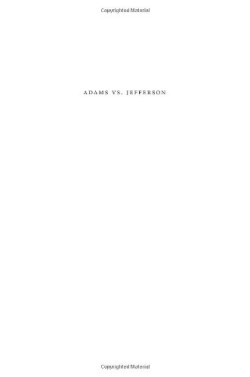Adams vs. Jefferson
The Tumultuous Election of 1800
Something unprecedented happened in 1800. The leader of a nation was booted out of office—peacefully. Without bloodshed, power in the United States of America was transferred from the defeated incumbent, John Adams, to the sitting vice president, Thomas Jefferson, a man from the opposing party and of contrasting political principles. For many historians, this was the consummation of the American Revolution.
From Oxford’s “Pivotal Moments in American History” series, this book offers an engaging study of an election that both underscored the emergence of America’s political parties and illuminated a glaring flaw in the young nation’s electoral system. The author, a State University of West Georgia history professor who has written several books on the founding fathers, offers a crisp review of the political decade leading up to the election as well as a close study of the four men—Adams, Jefferson, Charles Cotesworth Pinckney, and Aaron Burr—who sought the presidency.
Ferling describes the electoral college system established in the Constitution as “a calamity waiting to happen.” In a rare muddle-headed moment and acting upon the ill-conceived notion that with only one vote per elector there would be no clear winner, the founding fathers had created a system where each elector was to cast two votes; the person receiving the largest number of votes would be president and the runner-up vice president. This procedure wreaked havoc in 1796, failed badly in 1800, and was subsequently scrapped, but the electoral college remains, continuing to create mischief in today’s elections.
Without breaking new ground, Ferling affirms what others have written before, that Adams and Jefferson were an odd couple. Friends for much of their lives, they had mismatched temperaments, disparate lifestyles, and different dreams for the young republic. Individually, with Adams fearing a democratic tyranny and Jefferson an overbearing government, they were the embodiment of the Federalist and Republican parties.
Ferling writes that it was widely believed by the nation’s founders that what they put in place would be resistant to change. In this tightly stitched history, the reader can clearly see the political threads of 1800 that still run through the fabric of today’s presidential elections. Take campaigning. Four years earlier, in the election of 1796, the candidates had held onto the political tradition of early America—that the voters should come to them rather than they to the voters. By the election of 1800, Jefferson and Adams were acting like candidates, and their parties were engaging in what today would be decried as negative campaigning.
Reviewed by
Rob Mitchell
Disclosure: This article is not an endorsement, but a review. The publisher of this book provided free copies of the book to have their book reviewed by a professional reviewer. No fee was paid by the publisher for this review. Foreword Reviews only recommends books that we love. Foreword Magazine, Inc. is disclosing this in accordance with the Federal Trade Commission’s 16 CFR, Part 255.

